Dear Reader, this issue contains 28 articles including how-to's and reviews with information you can use to make a better movie. Whether you work in film or TV, or shoot and edit video, or shoot still photography and want to learn not only how to use the video capabilities of your camera, but how to use your tools to better tell your stories - you can put these tips and real-world techniques to practical use.
Working with Actors:
A DP's Perspective
by Peter Stein, ASC
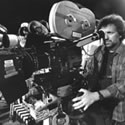
One of most the important relationships on a film set is how well the actors and the DP relate to each other. There is a great deal of interaction as the actors need to hit their marks, move to the best positions for lighting, stand up slowly and do a thousand other things so the scene works. Aside from being polite respectful and friendly, the cinematographer needs to make the actors look good - and the look needs to work for the scene being shoot.
[Read more]
Lighting for Depth: Techniques for Adding Depth to Your Shots
by Scott Spears
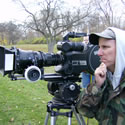
I highly recommend that you scout the locations out before the shoot, and if you can, bring the art director along. Working with the director, your job can be made easier by deciding on angles and knowing what kinds of props like lamps, paintings, furniture and other decorations you have available to set in your background. You will get an idea of what kind of light comes in from the existing lights and from the windows if there are any and how you can use it for the lighting schemes.
[Read more]
Shot in the Dark: A Sony A7S Setup that Opens Up New Shooting Possibilities
by Jon Firestone
This year the Sony A7S camera came out, and the really exciting thing about this camera is its ability to shoot at extremely high ISOs making it by far the best low light camera that I have ever seen. The camera itself has some real limitations so I've coupled it with an Odyssey 7Q+ recorder/monitor which makes it a much better system. I've also been using some new small battery powered LED Scorpion lights, which are great for this sort of shooting. I'm also using the Neat Video denoising plugin which allows me to shoot at even higher ISOs and "Fix it in Post".
[Read more]
Mastering the Master:
7 Important Things You Should Know
by Jack Sholder
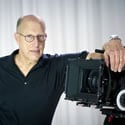
There is no rulebook that tells directors what a master is and why they need to shoot one. While I was a working director I shot masters and didn't think much about it most of the time. When I began to teach directing, I realized I needed to think about the things I didn't much think about so I could explain the process in a way that was useful and comprehensible to my students. Here are a few things I came up with.
[Read more]
Directing Means Communicating: Working With Your Cast and Crew
by Jonathan Moore
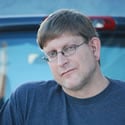 Being a good director means professionalism on the set. This means following the time-honored procedures of rehearsing, calling a shot and being specific with both cast and crew about what you want, as a director. It is no secret that many directors know exactly what they want - but do not have the ability or desire to communicate it. Here are a few tips to begin better communication skills on set...
Being a good director means professionalism on the set. This means following the time-honored procedures of rehearsing, calling a shot and being specific with both cast and crew about what you want, as a director. It is no secret that many directors know exactly what they want - but do not have the ability or desire to communicate it. Here are a few tips to begin better communication skills on set...
[Read more]
Directing and Acting in the Same Film: Learn the Craft of Acting to Up Your Game by Jeff Turboff

Actors want good roles. Actable roles. Stuff they can sink their teeth into. Multi-dimensional characters with full rich lives. Just what we on the other side of the camera want for our characters. Because of the fact that our work as writers and directors ultimately ends up in the hands of actors who must bring our vision to life, why should we handicap ourselves by not understanding how actors do what they do? Actors... good actors... are craftsmen and craftswomen with a highly technical skill of understanding and delivering the emotional intention of a story and each of its moments, as envisioned by the writer and director.
[Read more]
Audition Tips: How to Get the Right Actors for Your Films
by Peter John Ross
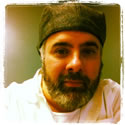
Tell the actor something about the character and the scene they are about to read. Then let them read it through without any direction. After one read, don't deliver the lines yourself and tell them "more like this..." (also called "line readings"), but ask them to do it again with more of the particular emotion you want. Tell them "how" you want them to act, don't show them. This is also called directing.
[Read more]
How to Use Action Verbs:
Adjusting the Intensity of Your Actor's Performance
by William Dickerson
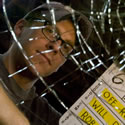
In every scene in a film, characters have goals they set out to achieve: to win an argument; to seduce a woman; to escape the clutches of a captor. In acting terms, these goals are called objectives. The means through which an actor goes about achieving these objectives is to use an action verb.
[Read more] |

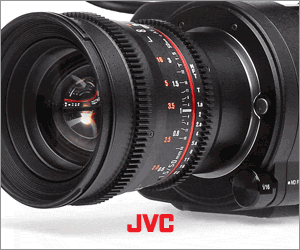
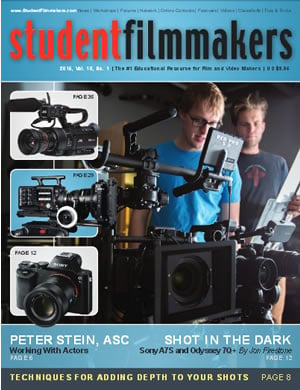
The Actor's Eyeline:
Notes on Camera Position
by Regge Life

When capturing your scene, whether it is drama or comedy, when you are doing "Over the Shoulder" (OTS) shots, it is important that you get your camera as close to the eyeline as possible.This means based on the 180 degree line, you want to get the lens as close to the line, basically have the camera positioned right over the "downstage" shoulder of the actor who is listening to the actor you are capturing.In this way, the actor's look or "eyeline" will appear more directed towards the person they are speaking to and not at some abstract point outside the frame.
[Read more]
The JVC GY-LS300 4K Handheld Camera: Craig Yanagi on the GY-LS300 4KCAM S35mm Camcorder

"With the GY-LS300's lensing flexibility, with accurate field of view acquisition, and fully supported H.264 file recording as well as live streaming capability, this camcorder is ideal for use in multiple curriculums, whether it be filmmaking or journalism. For film schools with 16mm prime lenses, they now have a means to not only use the glass, but use them as they are without recalculating for focal length. The widely supported H.264 file recording format (generic to DSLRs) enables the instructor to focus on the discipline and pedagogy of visual storytelling, and not have to worry about post production. All the instructor needs to do is add a lens and media - the GY-LS300 comes with everything else (mic, battery, power supply) included."
[Read more]

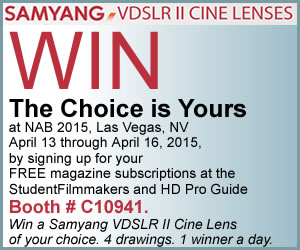
April 2015
NAB Show: April 11-16, Las Vegas, NV
www.nabshow.com
June 2015
Cine Gear Expo: June 4-7, Los Angeles
www.cinegearexpo.com
Cine Video Expo: June 15-19, Mexico
www.revistapantalla.com/expo
August 2015
2015 UFVA Conference: August 4-8, Washington, DC
ufva2015.com
Siggraph 2015: August 9-13, Los Angeles
s2015.siggraph.org
September 2015
IBC 2015: September 10-15, Amsterdam
www.ibc.org
October 2015
PhotoPlus Expo 2015: October 21-24, New York City
www.photoplusexpo.com
December 2015
GV Expo 2015: December 1-3, Washington, DC
www.gvexpo.com
MAGAZINE ADVERTISING CONTACTS
Kim Edward Welch, (917) 743-8381
Email: [email protected]
Publisher / Sales
Jody Michelle Solis, (646) 509-3160
Email: [email protected]
Editor-in-Chief / Specialty Sales |
